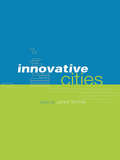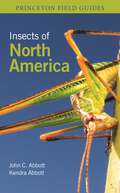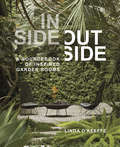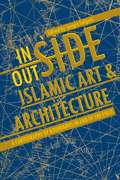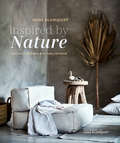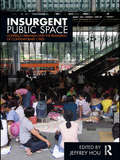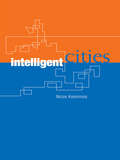- Table View
- List View
Innovative Cities
by James SimmieInnovative Cities presents a unique international comparison of innovation in Amsterdam, London, Milan, Paris and Stuttgart. Based on research funded by the ESRC program on 'Cities: Competitiveness and Cohesion', it compares and contrasts the reasons why these sites are among the top ten innovative cities in Europe. Innovation is one of the key driving forces of economic growth in modern economies.The research reported here takes a careful and directly comparable look at what characteristics and conditions in the five cities have led to the flourishing of innovation in them. Researchers with detailed local knowledge have applied the same analytical tools and survey techniques to investigating this question and the result present a unique international comparison of innovation in the five cities.
Innovative Community Responses to Disaster (Community Development – Current Issues Series)
by Brent D. Hales, Norman Walzer and James R. CalvinIncreasingly, community leaders around the world face major natural and economic disasters that require them to find ways to rebuild both physical infrastructure and the local economy. Doing this effectively requires an understanding of how various parts of the community are interconnected, as well as information as to which revitalization approaches have succeeded in the past. Community investment in recovery is essential and, in some cases, may require local leaders to rethink how it can be financed and arranged. This book presents a conceptual framework based on the community capitals, and describes approaches that have succeeded in situations where local leaders have coordinated efforts to rebuild and revitalize local conditions. Contributions provide examples of successful approaches around the world, thus analysing potential strategies for addressing disasters of many different types in various cultural settings. In this way, the book provides insights into a variety of approaches based on applications of accepted community development theory and concepts. This book was originally published as a special issue of Community Development.
Innovative Community Responses to Disaster (Community Development – Current Issues Series)
by Brent D. Hales Norman Walzer James R. CalvinIncreasingly, community leaders around the world face major natural and economic disasters that require them to find ways to rebuild both physical infrastructure and the local economy. Doing this effectively requires an understanding of how various parts of the community are interconnected, as well as information as to which revitalization approaches have succeeded in the past. Community investment in recovery is essential and, in some cases, may require local leaders to rethink how it can be financed and arranged. This book presents a conceptual framework based on the community capitals, and describes approaches that have succeeded in situations where local leaders have coordinated efforts to rebuild and revitalize local conditions. Contributions provide examples of successful approaches around the world, thus analysing potential strategies for addressing disasters of many different types in various cultural settings. In this way, the book provides insights into a variety of approaches based on applications of accepted community development theory and concepts. This book was originally published as a special issue of Community Development.
Insects of North America (Princeton Field Guides #157)
by Dr. John C. Abbott Kendra K. AbbottThe ultimate photographic field guide to North American insectsThis amazing field guide enables you to identify all 783 families of insects currently recognized in the United States and Canada. Richly illustrated with more than 3,700 stunning photos along with keys to families for many of the orders, Insects of North America features a comprehensive introduction that discusses classification and nomenclature, insect diversity, global threats, the latest collecting and curatorial techniques, and the many ways these remarkable organisms impact society. Combined with in-depth taxonomic coverage, this is the essential resource for both professionals and amateurs interested in the most diverse group of animals on the planet.Covers all 783 insect families known to occur in the United States and CanadaFeatures more than 3,700 color photos, with nearly every photo identified to species levelIncludes an illustrated glossary for easy reference in the fieldThe first field companion of its kind since the publication of the Peterson guide in 1970Ideal for entomology courses of all levelsAn invaluable resource for anyone interested in insects
Inside Information: The defining concepts of interior design
by Sally Stone Edward HollisEvery built structure has an interior: whether it takes the rough form of a rudimentary shelter, the grey walls of a hospital or the finessed decoration of a one-off residence. We spend most of our time inside buildings. Shut your eyes and you will find yourself in your own interior. You will always be inside. Mastering the language, thinking and history of the interior is critical to understanding and designing spaces. This essential primer transcends the boundaries and genres that often define interiors, providing a comprehensive view of the concepts and vocabulary of interior design. Written as an accessible ‘treasury’ of principal terms and ideas, Inside Information engages with the past, uncovering the future potential of the interior, and its design. Introduces the reader to 26 key terms, from ante- to zeitgeist. Covers areas of study from the very practical – structures, decoration and sustainability – to the philosophical – gender, space and light. Features sources, ranging from: Le Corbusier to Norman Foster; Jacques Derrida to Noam Chomsky; Virginia Woolf to George Orwell. Highly illustrated with over 100 photographs and drawings.
Inside Information: The defining concepts of interior design
by Sally Stone Edward HollisEvery built structure has an interior: whether it takes the rough form of a rudimentary shelter, the grey walls of a hospital or the finessed decoration of a one-off residence. We spend most of our time inside buildings. Shut your eyes and you will find yourself in your own interior. You will always be inside. Mastering the language, thinking and history of the interior is critical to understanding and designing spaces. This essential primer transcends the boundaries and genres that often define interiors, providing a comprehensive view of the concepts and vocabulary of interior design. Written as an accessible ‘treasury’ of principal terms and ideas, Inside Information engages with the past, uncovering the future potential of the interior, and its design. Introduces the reader to 26 key terms, from ante- to zeitgeist. Covers areas of study from the very practical – structures, decoration and sustainability – to the philosophical – gender, space and light. Features sources, ranging from: Le Corbusier to Norman Foster; Jacques Derrida to Noam Chomsky; Virginia Woolf to George Orwell. Highly illustrated with over 100 photographs and drawings.
Inside Outside: A Sourcebook of Inspired Garden Rooms
by Linda O'KeeffeUsing the principles and language of interior design, Inside Outside offers a fresh and inspirational look at creating inviting, beautiful, and personalized outdoor rooms.
Inside/Outside Islamic Art and Architecture: A Cartography of Boundaries in and of the Field
by Saygin SalgirliWhen we walk into a gallery, we have a fairly good idea where the building begins and ends; and inside, while observing a painting, we are equally confident in distinguishing between the painting-proper and its frame and borders. Yet, things are often more complicated. A building defines an exterior space just as much as an interior, and what we perceive to be ornamental and marginal to a given painting may in fact be central to what it represents. In this volume, a simple question is presented: instead of dichotomous separations between inside and outside, or exterior and interior, what other relationships can we think of?The first book of its kind to grapple with this question, Inside/Outside Islamic Art and Architecture focuses on a wide spectrum of mediums and topics, including painted manuscripts, objects, architectural decoration, architecture and urban planning, and photography. Bringing together scholars with diverse methodologies-who work on a geographical span stretching from India to Spain and Nigeria, and across a temporal spectrum from the thirteenth to the twenty-first century-this original book also poses engaging questions about the boundaries of the field.
Inside/Outside Islamic Art and Architecture: A Cartography of Boundaries in and of the Field
When we walk into a gallery, we have a fairly good idea where the building begins and ends; and inside, while observing a painting, we are equally confident in distinguishing between the painting-proper and its frame and borders. Yet, things are often more complicated. A building defines an exterior space just as much as an interior, and what we perceive to be ornamental and marginal to a given painting may in fact be central to what it represents. In this volume, a simple question is presented: instead of dichotomous separations between inside and outside, or exterior and interior, what other relationships can we think of?The first book of its kind to grapple with this question, Inside/Outside Islamic Art and Architecture focuses on a wide spectrum of mediums and topics, including painted manuscripts, objects, architectural decoration, architecture and urban planning, and photography. Bringing together scholars with diverse methodologies-who work on a geographical span stretching from India to Spain and Nigeria, and across a temporal spectrum from the thirteenth to the twenty-first century-this original book also poses engaging questions about the boundaries of the field.
Inspired by Light: A design guide to transforming the home
by Sally StoreyLighting has undergone a revolution in recent years, with new tools and technologies at our disposal: never before have there been so many options to achieve the transformative effects of light. Yet all too often, lighting – which does not just enable functionality, but also mood, aesthetics and flow – is misunderstood, or plain badly done. With so many options available, it’s also all too easy to make mistakes; and with new technologies such as LEDs lasting a long time, these mistakes can be expensive. Offering practical insight and visual inspiration on successful lighting solutions and schemes, this is the most accessible lighting design guide, offering a toolbox of techniques to apply in practice. Written by one of the UK's leading lighting designers on both commercial and residential projects, it features a variety of real-world projects – large and small, old and new, interior and exterior, UK and global.
Inspired by Light: A design guide to transforming the home
by Sally StoreyLighting has undergone a revolution in recent years, with new tools and technologies at our disposal: never before have there been so many options to achieve the transformative effects of light. Yet all too often, lighting – which does not just enable functionality, but also mood, aesthetics and flow – is misunderstood, or plain badly done. With so many options available, it’s also all too easy to make mistakes; and with new technologies such as LEDs lasting a long time, these mistakes can be expensive. Offering practical insight and visual inspiration on successful lighting solutions and schemes, this is the most accessible lighting design guide, offering a toolbox of techniques to apply in practice. Written by one of the UK's leading lighting designers on both commercial and residential projects, it features a variety of real-world projects – large and small, old and new, interior and exterior, UK and global.
Inspired by Nature: Creating A Personal And Natural Interior
by Hans BlomquistIn Hans Blomquist's new book Inspired by Nature, the stylist and art director identifies the connection between our home environment and our emotional wellbeing.
Install Your Own Solar Panels: Designing and Installing a Photovoltaic System to Power Your Home
by Joseph Burdick Philip SchmidtThis comprehensive DIY guide shows homeowners how to install a whole-house photovoltaic system. Detailed photos, illustrations, and step-by-step instructions follow the same process professionals use — from planning and designing to installing rooftop and ground-mounted tracks.
Instructions in Gardening for Ladies: The original 1834 classic gardening book
by Jane C LoudonHaving married a gardening expert, it seemed to Jane C Loudon, that everyone around her knew far more about plants and gardening than she did, but she quickly learned the art of horticulture from her husband and decided to pass his teachings on to other ladies to help them enjoy the delights of the garden. Gardening for Ladies was, and still is, an entirely practical book that describes how a lady can make the most of her garden in a clear and precise way. Digging over a flowerbed might have been work for a rough-handed, rope-muscled garden worker, but Jane explained how a lady could tackle the job without undue strain, and explained why it was necessary. The advice and instruction in this classic gardening book is as relevant today as it was when it was written 180 years ago.
Instruments of Land Policy: Dealing with Scarcity of Land (Urban Planning and Environment)
by Jean-David Gerber Thomas Hartmann Andreas HengstermannIn dealing with scarce land, planners often need to interact with, and sometimes confront, property right-holders to address complex property rights situations. To reinforce their position in situations of rivalrous land uses, planners can strategically use and combine different policy instruments in addition to standard land use plans. Effectively steering spatial development requires a keen understanding of these instruments of land policy. This book not only presents how such instruments function, it additionally examines how public authorities strategically manage the scarcity of land, either increasing or decreasing it, to promote a more sparing use of resources. It presents 13 instruments of land policy in specific national contexts and discusses them from the perspectives of other countries. Through the use of concrete examples, the book reveals how instruments of land policy are used strategically in different policy contexts.
Instruments of Land Policy: Dealing with Scarcity of Land (Urban Planning and Environment)
by Jean-David Gerber Thomas Hartmann Andreas HengstermannIn dealing with scarce land, planners often need to interact with, and sometimes confront, property right-holders to address complex property rights situations. To reinforce their position in situations of rivalrous land uses, planners can strategically use and combine different policy instruments in addition to standard land use plans. Effectively steering spatial development requires a keen understanding of these instruments of land policy. This book not only presents how such instruments function, it additionally examines how public authorities strategically manage the scarcity of land, either increasing or decreasing it, to promote a more sparing use of resources. It presents 13 instruments of land policy in specific national contexts and discusses them from the perspectives of other countries. Through the use of concrete examples, the book reveals how instruments of land policy are used strategically in different policy contexts.
Insurgent Public Space: Guerrilla Urbanism and the Remaking of Contemporary Cities
by Jeffrey HouWinner of the EDRA book prize for 2012. In cities around the world, individuals and groups are reclaiming and creating urban sites, temporary spaces and informal gathering places. These ‘insurgent public spaces’ challenge conventional views of how urban areas are defined and used, and how they can transform the city environment. No longer confined to traditional public areas like neighbourhood parks and public plazas, these guerrilla spaces express the alternative social and spatial relationships in our changing cities. With nearly twenty illustrated case studies, this volume shows how instances of insurgent public space occur across the world. Examples range from community gardening in Seattle and Los Angeles, street dancing in Beijing, to the transformation of parking spaces into temporary parks in San Francisco. Drawing on the experiences and knowledge of individuals extensively engaged in the actual implementation of these spaces, Insurgent Public Space is a unique cross-disciplinary approach to the study of public space use, and how it is utilized in the contemporary, urban world. Appealing to professionals and students in both urban studies and more social courses, Hou has brought together valuable commentaries on an area of urbanism which has, up until now, been largely ignored.
Insurgent Public Space: Guerrilla Urbanism and the Remaking of Contemporary Cities
by Jeffrey HouWinner of the EDRA book prize for 2012. In cities around the world, individuals and groups are reclaiming and creating urban sites, temporary spaces and informal gathering places. These ‘insurgent public spaces’ challenge conventional views of how urban areas are defined and used, and how they can transform the city environment. No longer confined to traditional public areas like neighbourhood parks and public plazas, these guerrilla spaces express the alternative social and spatial relationships in our changing cities. With nearly twenty illustrated case studies, this volume shows how instances of insurgent public space occur across the world. Examples range from community gardening in Seattle and Los Angeles, street dancing in Beijing, to the transformation of parking spaces into temporary parks in San Francisco. Drawing on the experiences and knowledge of individuals extensively engaged in the actual implementation of these spaces, Insurgent Public Space is a unique cross-disciplinary approach to the study of public space use, and how it is utilized in the contemporary, urban world. Appealing to professionals and students in both urban studies and more social courses, Hou has brought together valuable commentaries on an area of urbanism which has, up until now, been largely ignored.
An Integrated Approach to Home Security and Safety Systems
by Sonali Goyal Neera BatraThis book provides an integrated solution for security and safety in the home, covering both assistance in health monitoring and safety from strangers/intruders who want to enter the home with harmful intentions. It defines a system whereby recognition of a person/stranger at the door is done using three modules: Face Recognition, Voice Recognition and Similarity Index. These three modules are taken together to provide a percentage likelihood that the individual is in the "known" or "unknown" category. The system can also continuously monitor the health parameters of a vulnerable person living alone at home and aid them in calling for help in an emergency. The authors have analyzed a number of existing biometric techniques to provide security for an individual living alone at home. These biometric techniques have been tested using MATLAB® image processing and signal processing toolboxes, and results have been calculated on the basis of recognition rate. A major contribution in providing security is a hybrid algorithm proposed by the author named PICA, which combines features of both PCA (Principle Component Analysis) and ICA (Independent Component Analysis) algorithms. This hybrid approach gives better performance recognition than either system alone. The second proposed hybrid algorithm for voice recognition is named as a MFRASTA algorithm by combining features of MFCC (Mel Frequency Cepstral Coefficient) and RASTA-PLP (RelAtive SpecTrA-Perceptual Linear Prediction) algorithm. After performing experiments, results are collected on the basis of recognition rate. The authors have also proposed a third technique named as a Similarity Index to provide trust-based security for an individual. This technique is text independent in which a person is recognized by pronunciation, frequency, tone, pitch, etc., irrespective of the content spoken by the person. By combining these three techniques, a high recognition rate is provided to the person at the door and high security to the individual living independently at home. In the final contribution, the authors have proposed a fingertip-based application for health monitoring by using the concept of sensors. This application is developed using iPhone 6’s camera. When a person puts their fingertip on a camera lens, with the help of brightness of the skin, the person’s heartbeat will be monitored. This is possible even with a low-quality camera. In case of any emergency, text messages will be sent to the family members of the individual living alone by using 3G Dongle and MATLAB tool. Results show that the proposed work outperforms all the existing techniques used in face recognition, voice recognition, and health monitoring alone.
An Integrated Approach to Home Security and Safety Systems
by Sonali Goyal Neera BatraThis book provides an integrated solution for security and safety in the home, covering both assistance in health monitoring and safety from strangers/intruders who want to enter the home with harmful intentions. It defines a system whereby recognition of a person/stranger at the door is done using three modules: Face Recognition, Voice Recognition and Similarity Index. These three modules are taken together to provide a percentage likelihood that the individual is in the "known" or "unknown" category. The system can also continuously monitor the health parameters of a vulnerable person living alone at home and aid them in calling for help in an emergency. The authors have analyzed a number of existing biometric techniques to provide security for an individual living alone at home. These biometric techniques have been tested using MATLAB® image processing and signal processing toolboxes, and results have been calculated on the basis of recognition rate. A major contribution in providing security is a hybrid algorithm proposed by the author named PICA, which combines features of both PCA (Principle Component Analysis) and ICA (Independent Component Analysis) algorithms. This hybrid approach gives better performance recognition than either system alone. The second proposed hybrid algorithm for voice recognition is named as a MFRASTA algorithm by combining features of MFCC (Mel Frequency Cepstral Coefficient) and RASTA-PLP (RelAtive SpecTrA-Perceptual Linear Prediction) algorithm. After performing experiments, results are collected on the basis of recognition rate. The authors have also proposed a third technique named as a Similarity Index to provide trust-based security for an individual. This technique is text independent in which a person is recognized by pronunciation, frequency, tone, pitch, etc., irrespective of the content spoken by the person. By combining these three techniques, a high recognition rate is provided to the person at the door and high security to the individual living independently at home. In the final contribution, the authors have proposed a fingertip-based application for health monitoring by using the concept of sensors. This application is developed using iPhone 6’s camera. When a person puts their fingertip on a camera lens, with the help of brightness of the skin, the person’s heartbeat will be monitored. This is possible even with a low-quality camera. In case of any emergency, text messages will be sent to the family members of the individual living alone by using 3G Dongle and MATLAB tool. Results show that the proposed work outperforms all the existing techniques used in face recognition, voice recognition, and health monitoring alone.
Intelligent Cities: Innovation, Knowledge Systems and Digital Spaces
by Nicos KomninosAt the turn of the century some cities and regions in Europe, Japan and the USA, displayed an exceptional capacity to incubate and develop new knowledge and innovations. The favourable environment for research, technology and innovation created in these areas was not immediately obvious, yet it was of great significance for a development based on knowledge, learning, and innovation. Intelligent Cities focuses on these environments of innovation, and the major models (technopoles, innovating regions, intelligent cities) for creating an environment-supporting technology, innovation, learning, and knowledge-based development.The introduction and the first chapter deal with innovation as an environmental condition, and with the geography and typology of islands of innovation. The next three parts focus on the theoretical paradigms and the planning models of the 'industrial district', the innovating region', and the 'intelligent city', which offer three alternative ways to create an environment of innovation.
Intelligent Cities: Innovation, Knowledge Systems and Digital Spaces (Regions And Cities Ser.)
by Nicos KomninosAt the turn of the century some cities and regions in Europe, Japan and the USA, displayed an exceptional capacity to incubate and develop new knowledge and innovations. The favourable environment for research, technology and innovation created in these areas was not immediately obvious, yet it was of great significance for a development based on knowledge, learning, and innovation. Intelligent Cities focuses on these environments of innovation, and the major models (technopoles, innovating regions, intelligent cities) for creating an environment-supporting technology, innovation, learning, and knowledge-based development.The introduction and the first chapter deal with innovation as an environmental condition, and with the geography and typology of islands of innovation. The next three parts focus on the theoretical paradigms and the planning models of the 'industrial district', the innovating region', and the 'intelligent city', which offer three alternative ways to create an environment of innovation.
The Intercultural City: Planning for Diversity Advantage
by Charles Landry Phil WoodIn a world of increasing mobility, how people of different cultures live together is a key issue of our age, especially for those responsible for planning and running cities. New thinking is needed on how diverse communities can cooperate in productive harmony instead of leading parallel or antagonistic lives. Policy is often dominated by mitigating the perceived negative effects of diversity, and little thought is given to how adiversity dividend or increased innovative capacity might be achieved. The Intercultural City, based on numerous case studies worldwide, analyses the links between urban change and cultural diversity. It draws on original research in the US, Europe, Australasia and the UK. It critiques past and current policy and introduces new conceptual frameworks. It provides significant and practical advice for readers, with new insights and tools for practitioners such as theintercultural lensindicators of opennessurban cultural literacy andten steps to an Intercultural City. Published with Comedia.
The Intercultural City: Planning for Diversity Advantage
by Charles Landry Phil WoodIn a world of increasing mobility, how people of different cultures live together is a key issue of our age, especially for those responsible for planning and running cities. New thinking is needed on how diverse communities can cooperate in productive harmony instead of leading parallel or antagonistic lives. Policy is often dominated by mitigating the perceived negative effects of diversity, and little thought is given to how adiversity dividend or increased innovative capacity might be achieved. The Intercultural City, based on numerous case studies worldwide, analyses the links between urban change and cultural diversity. It draws on original research in the US, Europe, Australasia and the UK. It critiques past and current policy and introduces new conceptual frameworks. It provides significant and practical advice for readers, with new insights and tools for practitioners such as theintercultural lensindicators of opennessurban cultural literacy andten steps to an Intercultural City. Published with Comedia.
Interior Architecture: From Brief to Build
by Jennifer HudsonInterior Architecture provides an in-depth study of the creative and construction processes behind 30 contemporary interior designs. Covering a broad range of international projects, the book illustrates the working methods and creative concerns of both long-established and emerging international designers. Every stage of the project is included, from the demands of the original brief, through early sketches and design development to investigation of building regulations and collaboration with engineers, contractors, builders, and suppliers. Each project is presented through an explanatory overview, shots of production and construction processes, and details of fixtures, fittings, customized furnishings, and decoration. Interior Architecture offers both students and professional designers, an inspiring and informative overview of how today's major interior architectural projects are designed and built.
